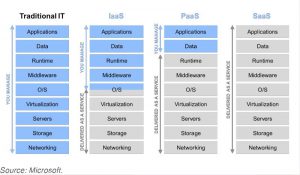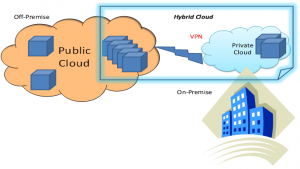Microsoft Azure CLOUD COMPUTING – Bestdotnettraining
Introduction: This article explains all about Cloud Computing.
Topics covered:
- What is Cloud Computing?
- Why businesses are moving to Cloud?
- Cloud Characteristics.
- Cloud Computing Service Models – IaaS, PaaS, SaaS.
- Deployment Models in Cloud Computing.
- Advantages and Disadvantages of Cloud Computing.
- Cloud Computing Job Roles.
- Cloud Computing Platforms and Certifications.
Description:
- What is Cloud Computing?
Cloud: a metaphor for the Internet.
Cloud Computing: A type of Internet-based computing where different services — Storing and accessing data and programs over — are delivered to an organization’s computers and devices through the Internet.
A cloud computing service consists of highly optimized data centers (third-party data centers from the end user point of view), that provide various hardware, software and information resources (when needed).
Why is Cloud Platform preferred?
- The cloud platform is preferred because it hides the complexity of the underlying infrastructure from users and applications by providing a very simple graphical interface or API (Applications Programming Interface).
- The Cloud platform provides on-demand services that are always on, anywhere, anytime and anyplace.
- Why are businesses moving to cloud?
In traditional hosting, a software company has to deal with-
- Licensing costs
- Protection of data
- Frequent upgrades to latest technologies/versions
- Maintenance and up -gradation of hardware and most important, find the right skill sets at the right time.
Businesses today, are moving to Cloud because of its amazing characteristics as below.
- Cloud Characteristics
Characteristics of Cloud computing-
- Remotely hosted: Data or services are hosted on remote infrastructure.
- Ubiquitous Data or services are available from any place through the internet.
- Resiliency: To minimize downtime in the event of a disaster, Cloud providers generally mirrors solutions to multiple data centers.
- Self – service, and On-demand: A consumer can himself provide computing capabilities, such as server time and network storage, automatically as required without requiring human interaction with each service’s provider. It is sold on demand mostly by the minutes or hours. (Pay as you go model)
- Elasticity – A user can utilize the cloud service as much/ less as required.
- Broad network access– Capabilities are available over the network and can be accessed through standard mechanisms that promote use by heterogeneous thin or thick client platforms (e.g., mobile phones, laptops, and PDAs).
- Fully managed by the provider – The user is unaware of the details of how the service is managed in the cloud. For example, the user need not worry about aspects such as hardware that is used, software updates and patches, plug-ins, web security. There is optimum utilization of resources and as well as sharing of these resources. All is taken care of by the provider.
Cloud Computing Service Models
Cloud Computing = Software as a Service (SaaS)+ Platform as a Service (PaaS)+ Infrastructure as a Service (IaaS)
1) IaaS (Infrastructure as a Service):
Delivers computer infrastructure (a platform virtualization environment) as a service.
- Cloud providers build data centers, scale, hardware, networking, managing power, storage distributed systems, etc…
- Rather than purchasing servers, software, network equipment, data center space or clients, buy those resources as a fully outsourced service.
Example: Amazon Web Services(AWS), Rackspace Hosting, VMWare, Citrix, Azure, Google Cloud
- PaaS (Platform as a Service):
- Provides necessary tools to the developers to create, test, host and maintain created applications.
- Cloud providers offer an Internet-based platform to developers who just create services but don’t prefer to build their own cloud.
Example: Microsoft Azure, Google Cloud, AWS
- SaaS (Software as a Service):
- SaaS is a software delivery methodology which provides licensed multi-tenant access to software and its functions remotely as a Web-based service.
- From end user’s point of view, applications are located in the cloud and it is almost always accessible through a web browser.
- Any application which is hosted on a remote server and can be accessed over the Internet is considered as SaaS.
Example: Microsoft Azure, Gmail, Google Apps (Office-like features), Sales Force CRM

Deployment Models in Cloud Computing
- Private Cloud:
- A private cloud hosting solution is also known as an internal or enterprise cloud, resides on the company’s intranet or hosted data center where all of your data is protected behind a firewall.
- This can be a good option for companies who already have expensive data centers because they can use their current infrastructure.
- You opt for a private cloud when you have strict security and data privacy
- Cons: The main drawback people see with a private cloud is that complete work of management, maintenance, and updating of data centers is the responsibility of the company.
- Public Cloud:
Public Clouds are the ones which are open for use by the general public and they exist beyond
the firewall of an organization fully hosted and managed by vendors.
Your data will be stored in the provider’s data center and the provider is responsible for the
management and maintenance of the data center.
Because you share computing resources among a network of users, the public cloud offers
greater flexibility and cost savings.
This is a good option if your demand for resources fluctuates. You will just purchase the capacity
on the basis of usage and can scale up or scale down server capabilities based on traffic and
other dynamic requirements.
The public cloud environment is appealing to many companies as it reduces lead times in testing
and deploying new products.
Cons: They are more vulnerable than private clouds and there is no control of who uses/ shares
the resources.
Note: Even though you don’t control the security of a public cloud, all of your data remains
separate from others and security breaches of public clouds are extremely rare.
- Hybrid Clouds:
Hybrid Clouds are a mix of public and private clouds, consisting of external and internal providers.
Secure apps are managed by the organization and the not-so-secure apps by the third party
vendor. For example, you can use a public cloud to interact with the clients but keep their data
secured within a private cloud. Most companies are now switching to Hybrid clouds.
Hybrid Clouds are Ideal in situations where you have planned are to migrate to a complete cloud a
solution as existing hardware expires or you have some applications or hardware that are not ready
for the cloud.

Advantages and Disadvantages of Cloud Computing
Advantages of Cloud Computing:
- 1. Lower Computer Cost
- 2. Improved Performance.
- 3. Reduced Software Cost and Instant Software Updates.
- 4. Unlimited Storage Capacity.
- 5. Universal Document Access.
- 6. Increased data reliability.7. Device Independence.
Disadvantage of Cloud Computing:
- Requires a constant Internet connection.
- Does not work well with low-speed connections.
- Features might be limited based on the provider you choose.
- Can be slow.
- Stored data might not be safe/ secure.

